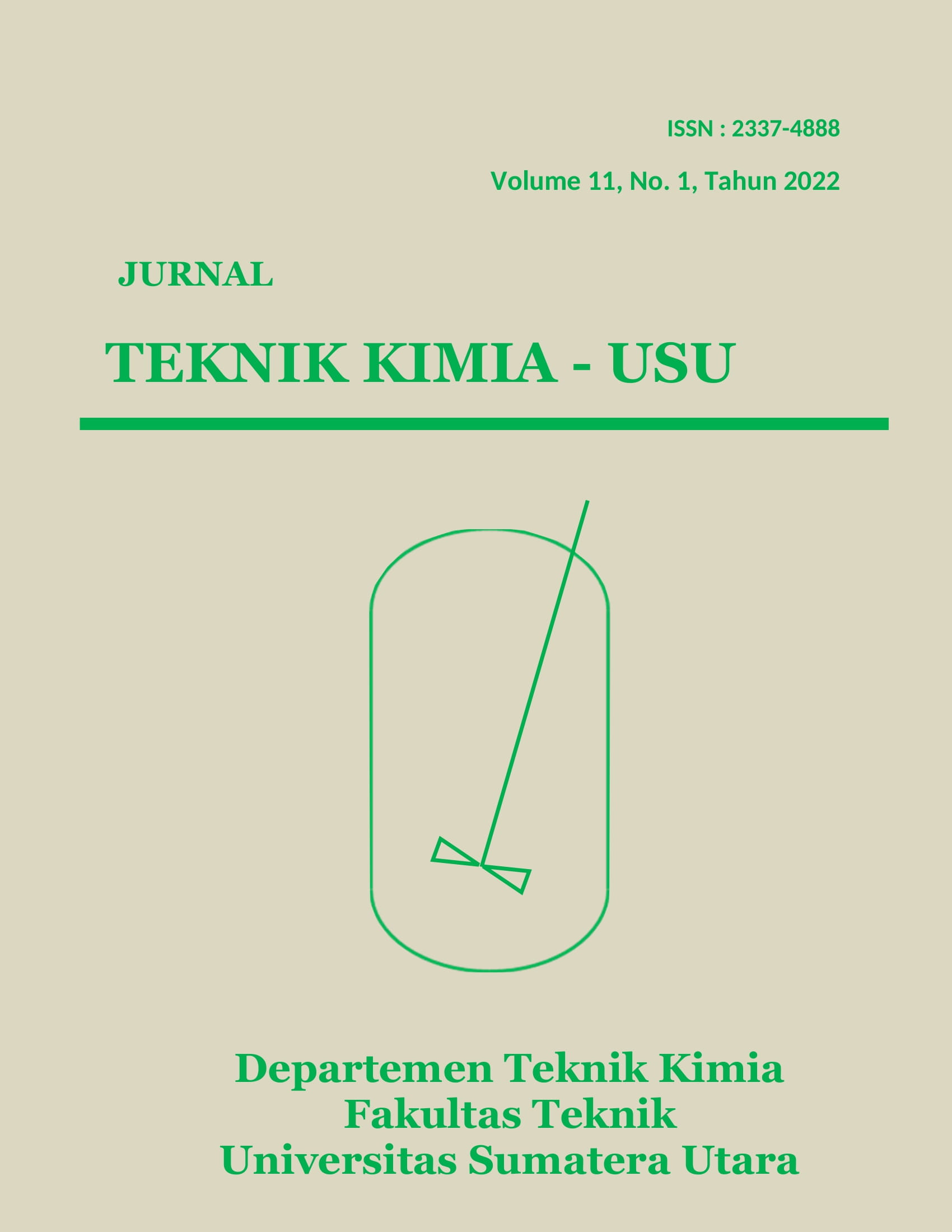Hidrolisis Eceng Gondok (Eichhornia Crassipes) Menjadi Glukosa Menggunakan Rotating Microwave Reactor
DOI:
https://doi.org/10.32734/jtk.v11i1.6760Keywords:
water hyacinth, hydrolysis, rotating microwave, Arrhenius equationAbstract
Water hyacinth is lignocellulosic biomass that has the potential for glucose production because it contains 64.51% cellulose. Hydrolysis of water hyacinth was done in a rotating reactor with a microwave as a heat source. This study aims to obtain glucose by determining the hydrolysis reaction rate constant of power and sulfuric acid (H2SO4) concentration function and to find the best conditions for this hydrolysis process. Several research variables were H2SO4 concentration (0.5 N; 1 N; and 1.5 N), microwave power (600 W and 800 W) and reaction time of 60 minutes. Parameters measured were hydrolyzate temperature, glucose, and cellulose content. The hydrolysis reaction rate constant obtained based on the Arrhenius equation was k =1.30 x 10-2 e-132.172/T and the relationship between H2SO4 concentration and microwave power was C = 0.001P. The best conditions were obtained using 1 N H2SO4 and microwave power of 600 W with final glucose content of 486 mg/L.
Downloads
References
Elwin, M. Lutfi, and Y. Hendrawan, “Analisis pengaruh waktu pretreatment dan konsentrasi naoh terhadap kandungan selulosa, lignin dan hemiselulosa eceng gondok pada proses pretreatment pembuatan bioetanol,†J. Keteknikan Pertan. Trop. dan Biosist., vol. 2, no. 2, pp. 110–116, 2014.
R. Moeksin, L. Comeriorensi, and R. Damayanti, “Pembuatan bioetanol dari eceng gondok (Eichhornia crassipes) dengan perlakuan fermentasi,†J. Tek. Kim., vol. 22, no. 1, pp. 1–9, 2016.
J.C. Chen and J.S. Guo, “Improving the conversion efficiency of waste cotton to bioethanol by microwave hydrolysis technology,†Sustain. Environ. Res., vol. 23, pp. 333–339, Jan. 2013.
M. E. Saleem, R. Omar, S. M. M. Kamal, and D. R. A. Biak, “Microwave-assisted pretreatment of lignocellulosic biomass: A review,†J. Eng. Sci. Technol., vol. 10, pp. 97–109, 2015.
I. Madinah and M. Sarah, “Microwave assisted hydrolysis of oil palm empty fruit bunch: effect of wave distance sources, power, time and acid concentration,†IOP Conf. Ser. Mater. Sci. Eng., vol. 543, no. 1, pp. 0–7, 2019.
F. Merina and Y. Trihadiningrum, “Produksi bioetanol dari eceng gondok (Eichhornia crassipes) dengan Zymomonas mobilis dan Saccharomyces cerevisiae,†in Prosiding Seminar Nasional Manajemen Teknologi XIII, 2011, vol. 2, pp. 1–9.
A. R. Fachry, P. Astuti, and T. G. Puspitasari, “Pembuatan bioetanol dari limbah tongkol jagung dengan variasi konsentrasi asam klorida dan waktu fermentasi,†J. Tek. Kim., vol. 19, no. 1, pp. 60–69, 2013.
S. M. Nomanbhay, R. Hussain, and K. Palanisamy, “Microwave-assisted alkaline pretreatment and microwave assisted enzymatic saccharification of oil palm empty fruit bunch fiber for enhanced fermentable sugar yield,†J. Sustain. Bioenergy Syst., vol. 03, no. 01, pp. 7–17, 2013.
S. X. Chin, C. H. Chia, Z. Fang, S. Zakaria, X. K. Li, and F. Zhang, “A kinetic study on acid hydrolysis of oil palm empty fruit bunch fibers using a microwave reactor system,†Energy and Fuels, vol. 28, no. 4, pp. 2589–2597, 2014.
P. Coniwanti, S. Novalina, and I. K. Putri, “Pembuatan pulp eceng gondok melalui proses Organosolv,†J. Tek. Kim., vol. 16, no. 4, pp. 34–41, 2009.
TAPPI, Alpha-, beta- and gamma-cellulose in pulp Test Methods T 203 cm-99. Atlanta: Technical Association of the Pulp and Paper Industry. pp. 5–9, 1999.
S. M. D. Kolo and E. Edi, “Hidrolisis ampas biji sorgum dengan microwave untuk produksi gula pereduksi sebagai bahan baku bioetanol,†J. Saintek Lahan Kering, vol. 1, no. 2, pp. 22–23, 2018.
I. G. N. J. A. Prasetia, I. D. A. Yuliandari, D. G. Ulandari, C. I. S. Arisanti, and A. A. I. S. H. Dewandari, “Evaluasi kandungan selulosa mikrokristal dari jerami padi (Oryza sativa L.) Varietas IR64,†J. Kim., p. 97, 2018.
N. Erliyanti and E. Rosyidah, “Pengaruh daya microwave terhadap yield pada ekstraksi minyak atsiri dari bunga kamboja (Plumeria Alba) menggunakan metode microwave hydrodistillation,†J. Rekayasa Mesin, vol. 8, no. 3, pp. 175–178, 2017.
M. Muhaimin, B. Wulan Febriana, and S. Arfan, “Reaction kinetics in conversion process of pineapple leaves into glucose,†Reaktor, vol. 18, no. 03, pp. 155–159, 2018.
Z. S. Osvaldo, P. S. Putra, and M. Faizal, “Pengaruh konsentrasi asam dan waktu pada proses hidrolisis dan fermentasi pembuatan bioetanol dari alang-alang,†J. Tek. Kim., vol. 18, no. 2, pp. 52–62, 2012.
S. F. Salleh, R. Yunus, M. F. Atan, D. Radiah, and A. Biak, “Kinetic Studies on acid hydrolysis of OPEFB in a batch reactor,†in 2012 3rd International Conference on Chemistry and Chemical Engineering, 2012, vol. 38, pp. 132–136.
P. R Sarjono, N. S Mulyani, and W. S Setyani, “Kadar glukosa dari hidrolisis selulosa pada eceng gondok menggunakan trichoderma viride dengan variasi temperatur dan waktu fermentasi,†Molekul, vol. 7, no. 2, p. 163, 2012.
A. Xia, J. Cheng, W. Song, C. Yu, J. Zhou, and K. Cen, “Enhancing enzymatic saccharification of water hyacinth through microwave heating with dilute acid pretreatment for biomass energy utilization,†Energy, vol. 61, pp. 158–166, 2013.
Y. C. Lin, S. Shangdiar, S. C. Chen, F. C. Chou, Y. C. Lin, and C. A. Cho, “Microwave irradiation with dilute acid hydrolysis applied to enhance the saccharification rate of water hyacinth (Eichhornia crassipes),†Renew. Energy, vol. 125, pp. 511–517, 2018.
Downloads
Published
Issue
Section
License
Copyright (c) 2022 Jurnal Teknik Kimia USU

This work is licensed under a Creative Commons Attribution-ShareAlike 4.0 International License.

















